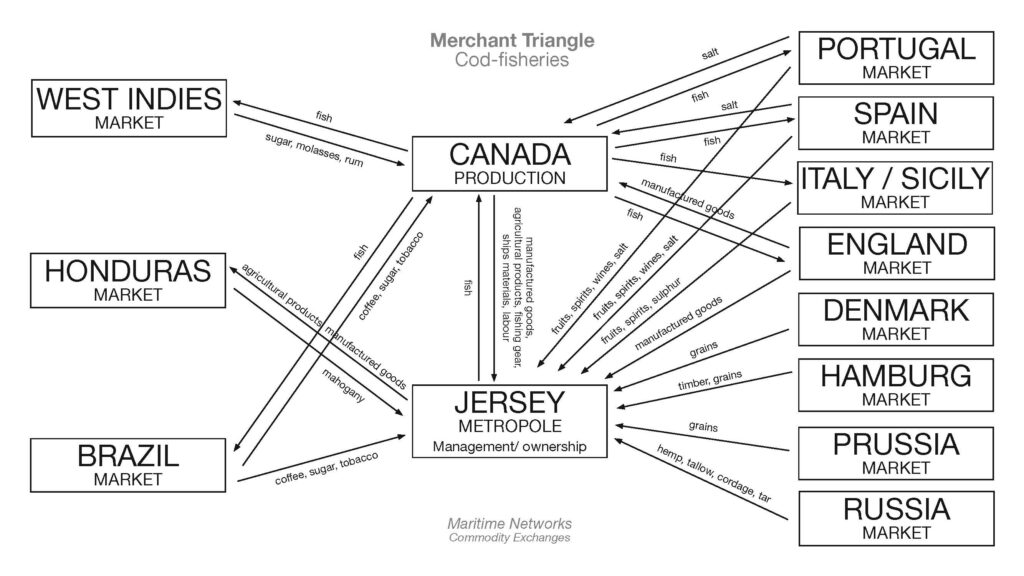What was the involvement of Jersey mariners in the Canadian cod-fisheries and the Transatlantic carrying trade?
It has been more than 400 years since the first Islanders crossed the Atlantic in search of work. They went to raid the cod-rich seas of the American and Canadian coast.
When the first Europeans reached Canada is unknown, but it is thought to be Italian explorer John Cabot’s descriptions of ‘new found lands’ and a sea swarming with fish in 1497 that attracted fishermen to the north of the continent.
By the beginning of the 16th-century Basque fishermen were travelling to the region to fish and, by 1580, around 10,000 European fishermen were making the transatlantic voyage to the area each year to fish for cod.
Channel Island fishermen were among these and by the 1750s they had set up lucrative trade routes between Canada, Europe and America, establishing bases on the Gaspé Coast where they could salt and prepare the cod for selling (merchants).

Which ports did Jersey ships sail to and trade with
A Collective effort to build harbours did not begin until the late 17th century, when work began on building a pier on the islet where St Aubin’s fort stands. During the 18th century St Aubin’s harbour proper was constructed and work began on developing St Helier as a port, although the capital had to wait until the 19th century before it really began to develop as a port.

It was during the early 19th century that stone piers were built at La Rocque, Bouley Bay, Rozel and Gorey, to accommodate the oyster boats. The harbour at Gorey also took passenger traffic from Normandy. The primary purpose of these harbours was the movement of cargoes and not people.
jersey fishermen voyaged to coasts such as Gaspé, here was where they salted and prepare the cod for trade and travel. All year round Fishermen could travel and fish, seas held large amounts of fish, nearer the coast proved itself hard for most fisherman who were unfamiliar with shallow waters, changing tided and rocky shores however Channel Islanders had plenty experience with coastal fishing and made use of their skills. Other ports included that on the Newfoundland, South America and others. Main ports which ships travelled to during their trades consisted of Bristol, London, Liverpool.
What type of goods did Jersey merchants exchange for cod-fish?
In Mediterranean countries cod was in high demand so was traded for: wine, brandy, dried fruit, citrus fruits and salt. There was also a demand in Brazil where the cod was traded for coffee and sugar.

To what extend, has the island of Jersey benefitted from its constitutional relationship with Britain and the legacies of colonialism based on a slave plantation economy during the first Industrial Revolution (1760-1840)?
- No 9 Pier road, is known as the ‘Merchant house’ and is a Victorian townhouse which was built by Philippe Nicolle in 1818 using money he inherited from his great uncles involvement in the transatlantic slave trade.
The building is now part of the Jersey museum.
- John Frederick Gibaut was a Jersey man who owned one of the largest sugar plantations, ran by slaves, in El Salvador during the mid 1800s. It ended up going bankrupt around the time slavery was abolished.
- TW: Peter Pierre, Thomas Mallet and Parry were jersey men who sailed with the captain John Kimber, in 1797 from Gold Coast to Barbados with 409 Slaves. Sadly one of the Slaves passed away on the boat and the captain was accused of killing her because she refused to dance naked.
In conclusion Jersey benefited economically from the slave trade due Jersey men who had businesses involving the trade and ship masters whose boats were used to capture slaves.
mood board/inspiration for up and coming harbour photoshoot

